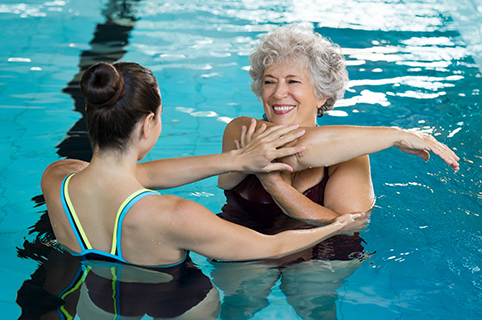
Photo: Courtesy of ATI Physical Therapy
By Brian Rog
In today’s world, the volume of physical therapy services available at our fingertips is unending. So, finding one that fits your needs and allows you to effectively return to a healthy routine can be a challenge.
Compare it to shoe shopping. With so many different styles and fits, finding the one shoe that’ll rocket you to the moon requires some effort. And finding your ideal therapy provider requires the same amount of energy. In most cases, your primary physicians can be a great starting point. But without the right questions and insight, you may end up back where you began. For this reason, it’s important to go a step further and connect with a local physical therapy provider to see what options are available to you.
When arriving at the rehabilitation phase of your recovery, the ultimate goal is to choose a no-risk therapy that’ll lessen recovery times and still get you back to an uninterrupted lifestyle. Typically, your rehabilitation options will range from a menu of traditional flat land therapies, which are still extremely effective injury recovery solutions. But many people aren’t aware that their options don’t have to stop there.
Thanks to advancements in technologies and accessibility, a lesser-publicized therapy known as aquatic therapy is steadily becoming a highly endorsed secondary option for a range of injury cases.
Given the countless mental and physical benefits provided through water, everyone from elite-level athletes to stroke survivors are benefitting from this low-impact, high-return therapy.
To answer some of your questions about whether or not aquatic therapy is right for you, ATI Physical Therapy is offering some help…

Photo: ATI Physical Therapy
Can Aquatic Therapy Still Yield the Same Outcomes as Traditional Therapies?
Simply put: Yes! The buoyancy property of the water tremendously helps to decrease the degree of weight-bearing, which ultimately lessens stress placed on the joints. When we say “weight-bearing,” we’re referring to the ability of the body to resist or support weight. For example, in chest-high water, the body is roughly 35 percent weight-bearing, which means that the body feels 65 percent less weight than it would on land.
Aquatic therapy is also a great segue into land-based therapies. This is especially true for back surgery patients who are restricted to wearing a thoracic-lumbo sacral orthosis (TLSO) and are limited in performance of land exercise. With the help of aquatic therapy, these patients are able to start with light aquatic exercise to prevent total deconditioning. Eventually, the aquatic exercise allows patients to gain strength and range of motion, which can make the transition to land-based PT much easier.
Who Benefits the Most From Aquatic Therapy Treatments?
Even though aquatic therapy can benefit just about anyone, it’s a favorable alternative therapy for individuals who are unable to tolerate traditional land-based exercises. It can also be beneficial for patients who are diagnosed with back and lower extremity ailments, fibromyalgia, gait and balance deficits, and people dealing with weight-bearing restrictions.

Photo: ATI Physical Therapy
Why Are More Physicians Turning to Aquatic Therapy Instead of Traditional Therapies?
For patients unable to achieve their goals in land-based therapies, whether it’s due to high pain levels, low tolerance, or severe restrictions, aquatic therapy is a second chance at a successful recovery. Post-surgical patients who would otherwise be restricted with land-based treatments can start with aquatic-based therapies earlier in their recovery to prevent deconditioning and help to transition them to land-based treatment, which ultimately results in favored outcomes.
Aquatic Therapy Is Said to Speed Up the Recovery Period Faster Than Land-Based Therapies. Why Is This?
Due to the decreased weight-bearing conditions of the aquatic environment, aquatic therapy allows patients to move with less restriction and less stress on their bodies. Because of this, a patient with severe osteoarthritis might not be able to walk the stairs in their home. But because their body weight decreases in the water, they may be able to perform step-ups in an aquatic environment. This allows for increased activation of the proper muscles needed to improve the step-up motion, which ultimately can help to improve the patient’s ability to perform stair negotiation in the home.
Post- or pre-surgical patients that would otherwise be restricted in their abilities to perform land-based therapy are able to begin therapy sooner in the water. Water therapy helps to increase the patient’s ability to start proper muscle recruitment and increase range of motion without increased pain.
What Are Some Lesser-Known Benefits of Aquatic Therapy?
Few are aware of this, but aquatic therapy can be great for patients who are diagnosed with multiple sclerosis (MS). Usually, patients with MS would perform aquatic exercises in a colder temperature pool as opposed to a warmer therapeutic pool. This is because warmer temperatures aren’t the most conducive environments for a patient with MS.
Aquatic therapy is also beneficial for patients with stress reactions and fractures, which are most common among athletes—especially runners. In fact, for injured athletes who refuse to surrender their on-the-go freedoms, exercising in an aquatic environment enables a continuation of conditioning. You can even run in the water without increasing stress.
And for patients who experience weakness and pain from nerve damage in the hands and feet, which is often referred to as peripheral neuropathy, aquatic therapy can be a helpful remedy. The hydrostatic pressure property of the water helps to decrease the swelling in these areas and improve proprioceptive awareness (internal body awareness).

Photo: ATI Physical Therapy
How Long Does a Standard Aquatic Therapy Session Last?
Depending on a patient’s tolerance, an aquatic therapy session usually lasts anywhere from 25 to 75 minutes.
Are There Any Drawbacks to Aquatic Therapy?
The most recognizable drawback to any activity in the water is drowning, which is why supervision is necessary whenever you get in the water. It’s also important to remember that even though the water allows us to perform exercises with ease because of the lessened weight-bearing conditions, your body is still working and pushing.
Doing too much, too fast can cause extreme muscle fatigue, which can result in soreness. Plus, outside of the pool, your body is back to experiencing full weight-bearing conditions. So, you’ll need to engage in transitional recovery training to avoid having a negative impact on your joints, muscles, and bones.
Is Aquatic Therapy Right for You?
With any recovery effort, the ultimate goal is to see results without the stress. And given the layers of physical and mental benefits afforded through aquatic therapy, it’s no surprise that more clinicians and patients are getting behind this treatment option.
For more information about aquatic therapy, contact a ATI Physical Therapy clinic near you.













